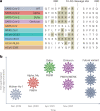SARS-CoV-2 variant biology: immune escape, transmission and fitness
- PMID: 36653446
- PMCID: PMC9847462
- DOI: 10.1038/s41579-022-00841-7
SARS-CoV-2 variant biology: immune escape, transmission and fitness
Abstract
In late 2020, after circulating for almost a year in the human population, severe acute respiratory syndrome coronavirus 2 (SARS-CoV-2) exhibited a major step change in its adaptation to humans. These highly mutated forms of SARS-CoV-2 had enhanced rates of transmission relative to previous variants and were termed 'variants of concern' (VOCs). Designated Alpha, Beta, Gamma, Delta and Omicron, the VOCs emerged independently from one another, and in turn each rapidly became dominant, regionally or globally, outcompeting previous variants. The success of each VOC relative to the previously dominant variant was enabled by altered intrinsic functional properties of the virus and, to various degrees, changes to virus antigenicity conferring the ability to evade a primed immune response. The increased virus fitness associated with VOCs is the result of a complex interplay of virus biology in the context of changing human immunity due to both vaccination and prior infection. In this Review, we summarize the literature on the relative transmissibility and antigenicity of SARS-CoV-2 variants, the role of mutations at the furin spike cleavage site and of non-spike proteins, the potential importance of recombination to virus success, and SARS-CoV-2 evolution in the context of T cells, innate immunity and population immunity. SARS-CoV-2 shows a complicated relationship among virus antigenicity, transmission and virulence, which has unpredictable implications for the future trajectory and disease burden of COVID-19.
© 2023. Springer Nature Limited.
Conflict of interest statement
The authors declare no competing interests.
Figures




References
-
- World Health Organization. https://www.who.int/news/item/05-05-2022-14.9-million-excess-deaths-were...WHO (2022).
Publication types
MeSH terms
Supplementary concepts
Grants and funding
LinkOut - more resources
Full Text Sources
Other Literature Sources
Medical
Miscellaneous

